Definition of the Thermodynamic Cycle of a Biomass-Fueled Internal Combustion Engine
Abstract
:1. Introduction
2. Methods
2.1. Introduction
2.1.1. Engine Diagram and Duty Cycle Characterization
2.1.2. System Setup
2.1.3. Assumed Simplifications
- The gases present in the chambers are considered to respond to the ideal diatomic gas laws. The engines run on air, which is mainly composed of nitrogen. Under working conditions, at relatively low pressures and well above its boiling point, nitrogen, and, therefore, air, behaves practically like a diatomic ideal gas.
- Nitrogen is considered an inert gas throughout the cycle. It does not react on combustion.
- The specific heats of the gases, and , are considered constant throughout the pressure and temperature range of the cycle.
- There are no thermal exchanges between the gases present in the chambers and their walls, or with the outside. Actually, there is considerable heat loss through the walls of the chambers. To obtain more realistic results, a lower value for the calorific value of the fuel (C) can be chosen.
- Combustion is considered an instantaneous phenomenon. Oxygen entering the combustion chamber is immediately consumed in combustion, producing heat.
- All the heat produced in combustion is used to heat the gases present in the combustion chamber.
- The total number of moles of gas remains constant after combustion, that is, . Actually, the number is increased a little by fuel breakdown.
- The volume of the combustion chamber occupied by the fuel remains constant., that is, . Actually, combustion produces a small decrease in the volume occupied by the fuel.
- Volume variations of the combustion chamber caused by the fuel supply system are not considered, .
- At the end of the compression stroke, the volume of the cylinder is considered to be reduced to zero. All the gases present in the cylinder enter the combustion chamber.
2.2. Compression Stage Study
2.2.1. Initial Conditions
- Pressure at the beginning of compression;
- Temperature in the cylinder at the beginning of compression;
- Compression ratio;
- Heating value of the fuel per kmol of air consumed.
2.2.2. Calculation of Chamber Volumes
2.2.3. Obtaining the p(v) Equation of Compression
2.3. Iterative-Numerical Method for Cycle Calculation
- The pressure depends on the work done from the beginning of the compression. Thus, the calculation must start at:The values of and are known and the value of is estimated. For the first iteration, . All of them allow values for and to be obtained:
- The compression process must be divided into small intervals (for example: ; ; ; etc.) so that it can be assumed that the quantities involved (, , and ) vary linearly within each of the intervals. This allows the calculation of the work done in each interval by applying the trapezoidal rule, considering only the pressure and the number of moles at the beginning and at the end of each of them.
- First, the pressure at the end of the interval must be estimated, always satisfying because the pressure increases continuously during compression.
- The work done is calculated with the trapezoidal rule using the estimated pressure value:where and take the following values:
- Since the compression in the cylinder is adiabatic, the value of can be calculated using the following equation:
- Then, , and can be calculated:
- The work done by the cylinder () can also be determined analytically. Since the number of moles of gas present in the cylinder decreases as compression progresses, the calculation considers the average between the moles present in the cylinder at the beginning and at the end of the interval. Therefore, the expression of is as follows:
- Then, the work done by the gases present in the combustion chamber () is:
- Once is known, the temperature can be calculated by applying the first law of thermodynamics:
- Finally, knowing , a value of the pressure in the combustion chamber () can be calculated.One of the conditions of the calculation is that the pressure must be the same in both chambers. If the estimated value for the pressure is correct, it will be true that . If it is not, the calculation must be repeated from point 3 with a different value of :
- If , must be increased.
- If , must be reduced.
2.4. Approximate Method for Cycle Calculation
2.4.1. Fitted Equation for Compression Stage
2.4.2. Cycle Resolution
2.4.3. Obtaining Work and Cycle Efficiency
3. Results
3.1. Iterative-Numerical Method Results
3.2. Approximate Method Results
3.3. Compression Stage Features
3.4. Comparison with the Otto Cycle
- The compression work of a biomass-fueled engine cycle, in absolute value, is higher. This is because compression and heat absorption occur at the same time;
- The peak pressure and temperature of the biomass-fueled engine cycle are higher than those of the Otto cycle. This is because the higher compression work heats the gases more during compression. As a result, at the end of compression stage, the final temperature, and, therefore, the pressure, is higher;
- The heat absorbed during the biomass-fueled engine cycle is less than the heat absorbed during the Otto cycle. This is because only the gases present in the cylinder are involved in combustion. In the Otto cycle, all the gases take part in combustion, and, therefore, the heat absorbed is higher.
3.5. Cycle Representation in a T–s Diagram
- The initial temperature is different for the gases from the cylinder (0A) and for those from the combustion chamber (0B);
- The absorption of heat, and, therefore, the generation of entropy, occurs in the combustion chamber. Therefore, line IB represents the compression stage in the combustion chamber. The gases in the cylinder undergo adiabatic compression and remain vertical to 0A (IA);
- Expansion (II) is an adiabatic transformation for both chambers. Since there is no heat exchange, the entropy does not change;
- Heat release (III) takes place exclusively in the cylinder. The gases in the cylinder are swept out and replaced by fresh gases. The combustion chamber gases are not replenished and remain at a high temperature.
4. Conclusions
Author Contributions
Funding
Data Availability Statement
Conflicts of Interest
Abbreviations
| Exponent of adiabatic transformation | |
| Cycle efficiency | |
| Air/fuel ratio of a combustion | |
| Calorific value of fuel per kmol of air consumed | |
| Specific heat of an ideal diatomic gas at constant pressure | |
| Specific heat of an ideal diatomic gas at constant volume | |
| Constant | |
| Combustion chamber filling factor | |
| Coefficients of the approximate equation | |
| Number of moles present in the cylinder volume | |
| Number of moles present in the combustion chamber | |
| Number of moles transferred from the cylinder to the combustion chamber | |
| Pressure of the gases present in the chambers | |
| Pressure obtained in the combustion chamber in the calculation | |
| Heat | |
| Ideal gas constant | |
| Compression ratio | |
| Entropy | |
| Temperature of the gases present in the cylinder volume | |
| Temperature of the gases present in the combustion chamber | |
| Internal energy | |
| Volume | |
| Cylinder volume (variable volume chamber) | |
| Useful volume of the combustion chamber | |
| Volume of the combustion chamber | |
| Work | |
| Work done by the gases present in the volume of the cylinder | |
| Work done by the gases present in the combustion chamber | |
| Dimensionless variable indicating compression progression: 0 onset; 1 final. |
Appendix A

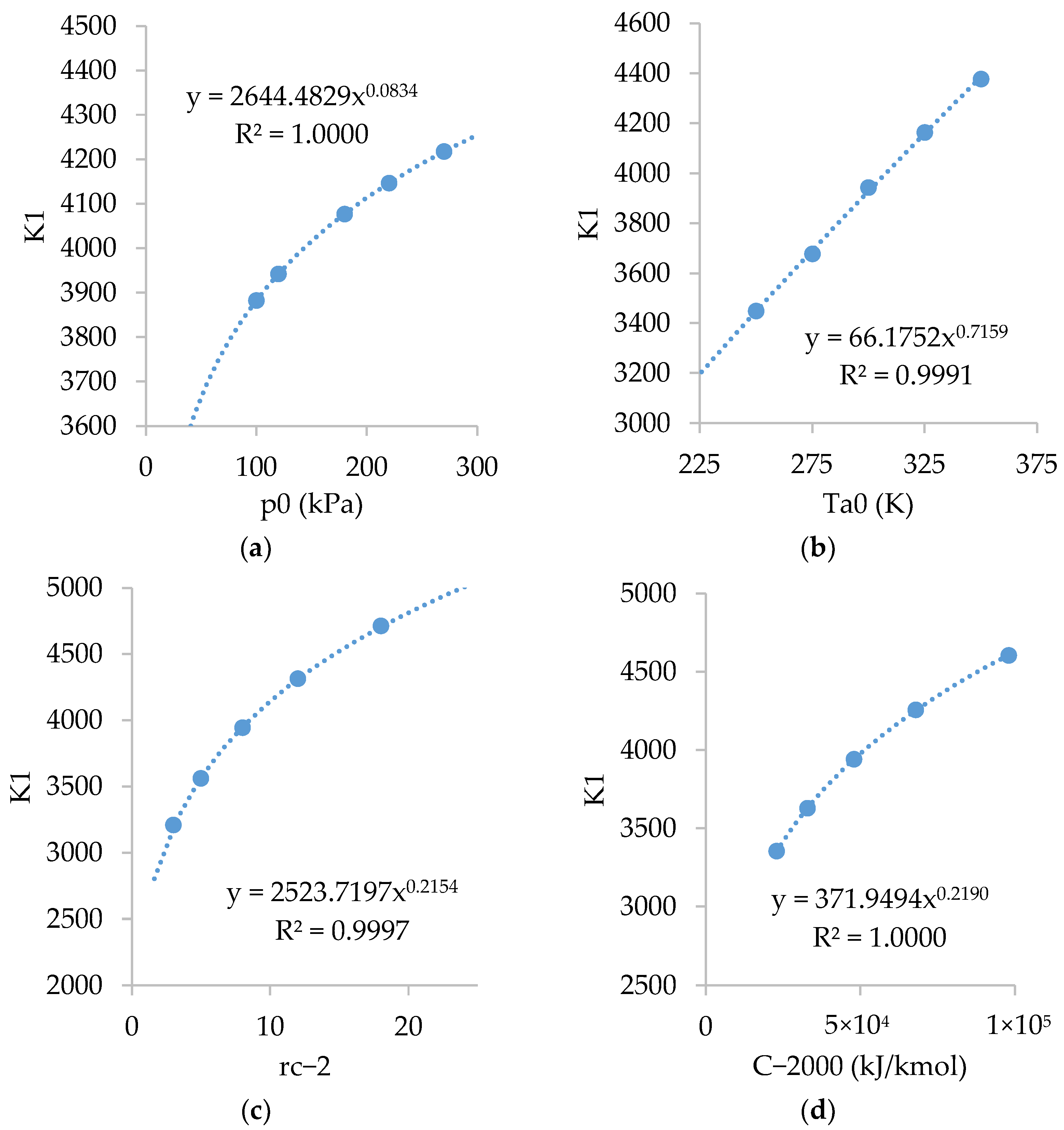
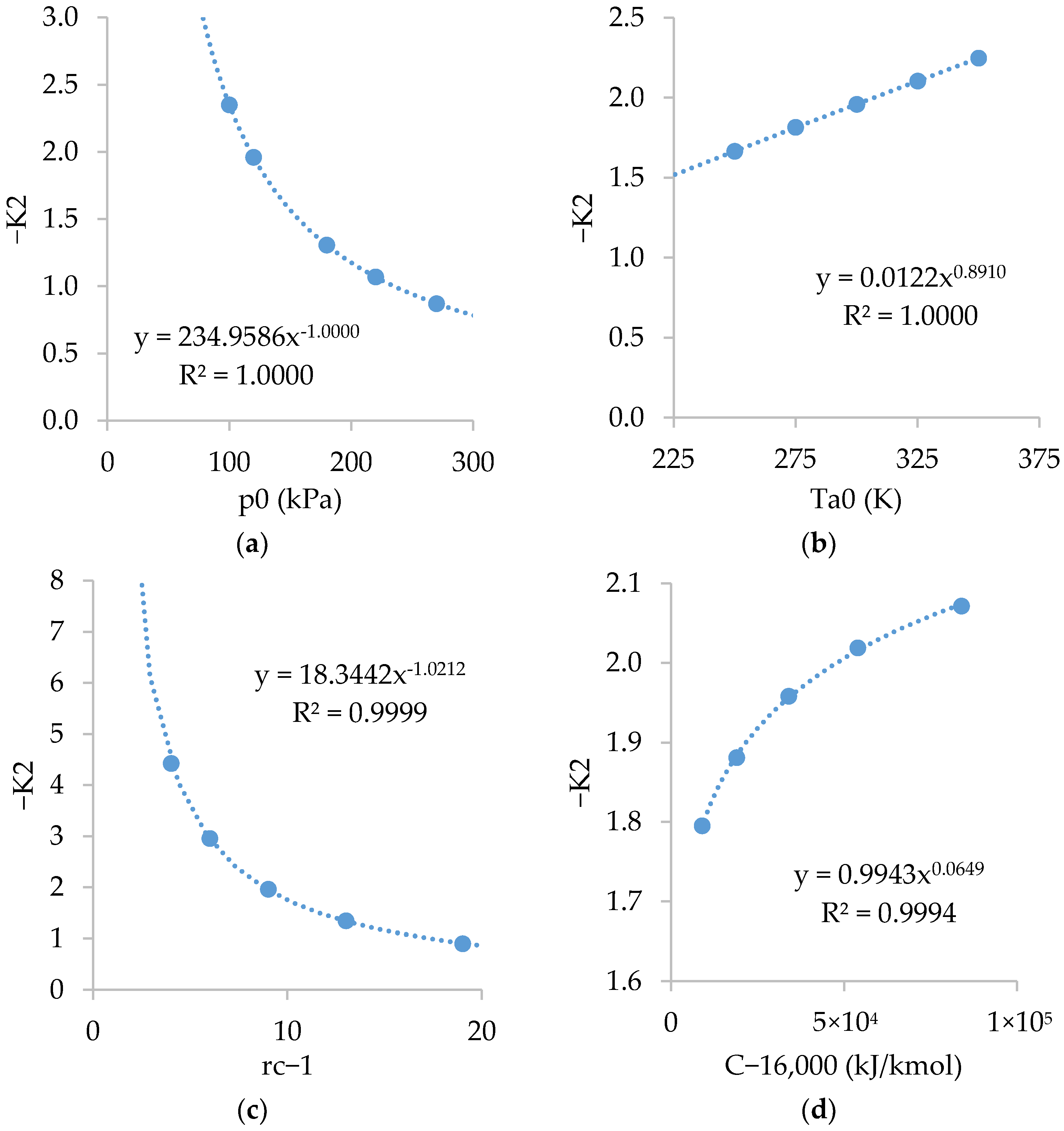

References
- Masson-Delmotte, V.; Zhai, P.; Pörtner, H.O.; Roberts, D.; Skea, J.; Shukla, P.R.; Pirani, A.; Moufouma-Okia, W.; Péan, C.; Pidcock, R.; et al. Global Warming of 1.5 °C. IPCC 2019, 1, 175. [Google Scholar]
- Chowdhury, A.; Corendea, C. Russia-Ukraine war could derail a renewable energy future. Hindustan Times 2022, 1, 3. [Google Scholar]
- Jaffe, A.M.; Medlock, K.B., III; Soligo, R. The status of world oil reserves: Conventional and unconventional resources in the future supply mix. James A Bak. III Inst. Public Policy Rice Univ. 2011, 1, 40. [Google Scholar]
- Stančin, H.; Mikulčić, H.; Wang, X.; Duić, N. A review on alternative fuels in future energy system. Renew. Sustain. Energy Rev. 2020, 128, 109927. [Google Scholar] [CrossRef]
- Zhang, R.; Fujimori, S. The role of transport electrification in global climate change mitigation scenarios. Environ. Res. Lett. 2020, 15, 034019. [Google Scholar] [CrossRef]
- De Borbón, J.C. Real Decreto 61/2006, de 31 de enero. BOE 2006, 12. [Google Scholar]
- Pimentel, D. Ethanol fuels: Energy balance, economics, and environmental impacts are negative. Nat. Resour. Res. 2003, 12, 127–134. [Google Scholar] [CrossRef]
- Kumari, D.; Singh, R. Pretreatment of lignocellulosic wastes for biofuel production: A critical review. Renew. Sustain. Energy Rev. 2018, 90, 877–891. [Google Scholar] [CrossRef]
- Gupta, A.; Verma, J.P. Sustainable bio-ethanol production from agro-residues: A review. Renew. Sustain. Energy Rev. 2015, 41, 550–567. [Google Scholar] [CrossRef]
- Brethauer, S.; Wyman, C.E. Review: Continuous hydrolysis and fermentation for cellulosic ethanol production. Bioresour. Technol. 2010, 101, 4862–4874. [Google Scholar] [CrossRef]
- Sala-Lizarraga, J.M.; López-González, L.M. Plantas de Valorización Energética de la Biomasa; Editorial Ochoa: Logroño, Spain, 2002; p. 311. ISBN 84-7359-545-91. [Google Scholar]
- Bacenetti, J.; Negri, M.; Fiala, M.; González-García, S. Anaerobic digestion of different feedstocks: Impact on energetic and environmental balances of biogas process. Sci. Total Environ. 2013, 463, 541–551. [Google Scholar] [CrossRef] [PubMed]
- Sawatdeenarunat, C.; Surendra, K.C.; Takara, D.; Oechsner, H.; Khanal, S.K. Anaerobic digestion of lignocellulosic biomass: Challenges and opportunities. Bioresour. Technol. 2015, 178, 178–186. [Google Scholar] [CrossRef] [PubMed]
- Pohl, M.; Heeg, K.; Mumme, J. Anaerobic digestion of wheat straw–Performance of continuous solid-state digestion. Bioresour. Technol. 2013, 146, 408–415. [Google Scholar] [CrossRef] [PubMed]
- Ahring, B.K.; Angelidaki, I.; de Macario, C.C.; Gavala, H.N.; Hofman-Bang, J.; Elfering, S.O.; Raskin, L.; Stams, A.J.; Westermann, P.; Zheng, D. Biomethanation I; Springer: Berlin, Germany, 2003; p. 231. [Google Scholar]
- Fore, S.R.; Porter, P.; Lazarus, W. Net energy balance of small-scale on-farm biodiesel production from canola and soybean. Biomass Bioenergy 2011, 35, 2234–2244. [Google Scholar] [CrossRef]
- Kallivroussis, L.; Natsis, A.; Papadakis, G. RD—Rural Development: The Energy Balance of Sunflower Production for Biodiesel in Greece. Biosyst. Eng. 2002, 81, 347–354. [Google Scholar] [CrossRef]
- Smith, E.G.; Janzen, H.H.; Newlands, N.K. Energy balances of biodiesel production from soybean and canola in Canada. Can. J. Plant Sci. 2007, 87, 793–801. [Google Scholar] [CrossRef]
- CORES. Informe Estadístico Anual 2019. CORES 2019, 1. [Google Scholar]
- Martinez Thomas, L. Producción de Combustibles de Emergencia a Partir de Biomasa; ESPOL: Madrid, Spain, 2015; p. 342. [Google Scholar]
- Chiaramonti, D.; Bonini, M.; Fratini, E.; Tondi, G.; Gartner, K.; Bridgwater, A.V.; Grimm, H.P.; Soldaini, I.; Webster, A.; Baglioni, P. Development of emulsions from biomass pyrolysis liquid and diesel and their use in engines—Part 2: Tests in diesel engines. Biomass Bioenergy 2003, 25, 101–111. [Google Scholar] [CrossRef]
- Arias-Paz, M. Manual de Automóviles; Cie Inversiones Editoriales Dossat: Madrid, Spain, 2004; p. 1199. [Google Scholar]
- Sazali, N. Emerging technologies by hydrogen: A review. Int. J. Hydrog. Energy 2020, 45, 18753–18771. [Google Scholar] [CrossRef]
- Martins, J.; Brito, F.P. Alternative fuels for internal combustion engines. Energies 2020, 13, 4086. [Google Scholar] [CrossRef]
- Bae, C.; Kim, J. Alternative fuels for internal combustion engines. Proc. Combust. Inst. 2017, 36, 3389–3413. [Google Scholar] [CrossRef]
- Moradi, R.; Groth, K.M. Hydrogen storage and delivery: Review of the state of the art technologies and risk and reliability analysis. Int. J. Hydrog. Energy 2019, 44, 12254–12269. [Google Scholar] [CrossRef]
- Rivard, E.; Trudeau, M.; Zaghib, K. Hydrogen Storage for Mobility: A Review. Materials 2019, 1, 22. [Google Scholar] [CrossRef] [PubMed] [Green Version]
- Praxair. Compressed hydrogen safety data sheet. Available online: https://www.praxair.co.in/gases/buy-compressed-hydrogen-gas-or-liquid-hydrogen (accessed on 10 November 2022).
- González, M.S.; Rojas-Hernández, I. hydrogen embrittlement of metals and alloys in combustion engines. Tecnol. En Marcha 2018, 31, 3–13. [Google Scholar]
- Wen, J.; Zhao, D.; Zhang, C. An overview of electricity powered vehicles: Lithium-ion battery energy storage density and energy conversion efficiency. Renew. Energy 2020, 162, 1629–1648. [Google Scholar] [CrossRef]
- Sarkar, T.; Bhattacharjee, A.; Mukhopadhyay, K.; Bhattacharya, K.D.; Saha, H. Energy non-availability in distribution grids with heavy penetration of solar power: Assessment and mitigation through solar smoother. Energies 2018, 11, 709. [Google Scholar] [CrossRef]
- Farmann, A.; Waag, W.; Marongiu, A.; Sauer, D.U. Critical review of on-board capacity estimation techniques for lithium-ion batteries in electric and hybrid electric vehicles. J. Power Sources 2015, 281, 114–130. [Google Scholar] [CrossRef]
- Cabrera, M.; Vera, A.; Cornejo, J.M.; Ordás, I.; Tolosana, E.; Ambrosio, Y.; Martínez, I.; Vignote, S.; Hotait, N.; Lafarga, A.; et al. Evaluación del Potencial de Energía de la Biomasa; Estudio técnico PER 2011–2020; IDAE: Madrid, Spain, 2011; p. 196.
- IDAE. Poderes caloríficos inferiores de las principales fuentes energéticas. Available online: https://view.officeapps.live.com/op/view.aspx?src=https%3A%2F%2Fwww.idae.es%2Fsites%2Fdefault%2Ffiles%2Festudios_informes_y_estadisticas%2Fpoderes-calorificos-inferiores_pci_v_1-00_2020.xlsx&wdOrigin=BROWSELINK (accessed on 10 November 2022).
- Ortega, M.A.C.; Alpírez, G.M.; González, C.G.; Sánchez, A.P.; Pelayo, L.J.P. Emisiones de las quemas de residuos agrícolas en el Valle de Mexicali, 1987–2010. SIIR 2011, 1, 5. [Google Scholar]
- Camia, A.; Robert, N.; Jonsson, K.; Pilli, R.; Garcia, C.S.; Lopez, L.R.; Van, D.; Ronzon, T.; Gurria, A.P.; M’Barek, R. Biomass production, supply, uses and flows in the European Union: First results from an integrated assessment. JRC Publ. Repos. 2018, 1, 47–67. [Google Scholar]
- 400.000 Viviendas Usan en España Calderas y Estufas de Biomasa; EUROPA PRESS Castilla y León; Europapress: London, UK, 2021.
- Clugniac, J.C. Gasógenos para Automotores; Aristides Quillet S.A.: Buenos Aires, Argentina, 1944; p. 270. [Google Scholar]
- Schnürle, A. Verbrennungskraftmaschine. U.S. Patent DE000000398997A.
- Firey, J.C. Char and oil burning engine. U.S. Patent 4,412,511, 1 November 1983. [Google Scholar]
- Firey, J.C. Untimed refuel, and ash removal for char burning engines. U.S. Patent 4,653,436, 31 March 1987. [Google Scholar]
- Piriou, B.; Vaitilingom, G.; Veyssière, B.; Cuq, B.; Rouau, X. Potential direct use of solid biomass in internal combustion engines. Prog. Energy Combust. Sci. 2013, 39, 169–188. [Google Scholar] [CrossRef]
- Fritts, D.K. Particulate deflagration combustion engine. U.S. Patent 7,784,435, 31 August 2010. [Google Scholar]
- Klöpperpieper, R. Von Glühkopf-, Halbdiesel- und Volldieselmotoren. Landwirtsch. Wochenbl. 2006, 31, 28–29. [Google Scholar]

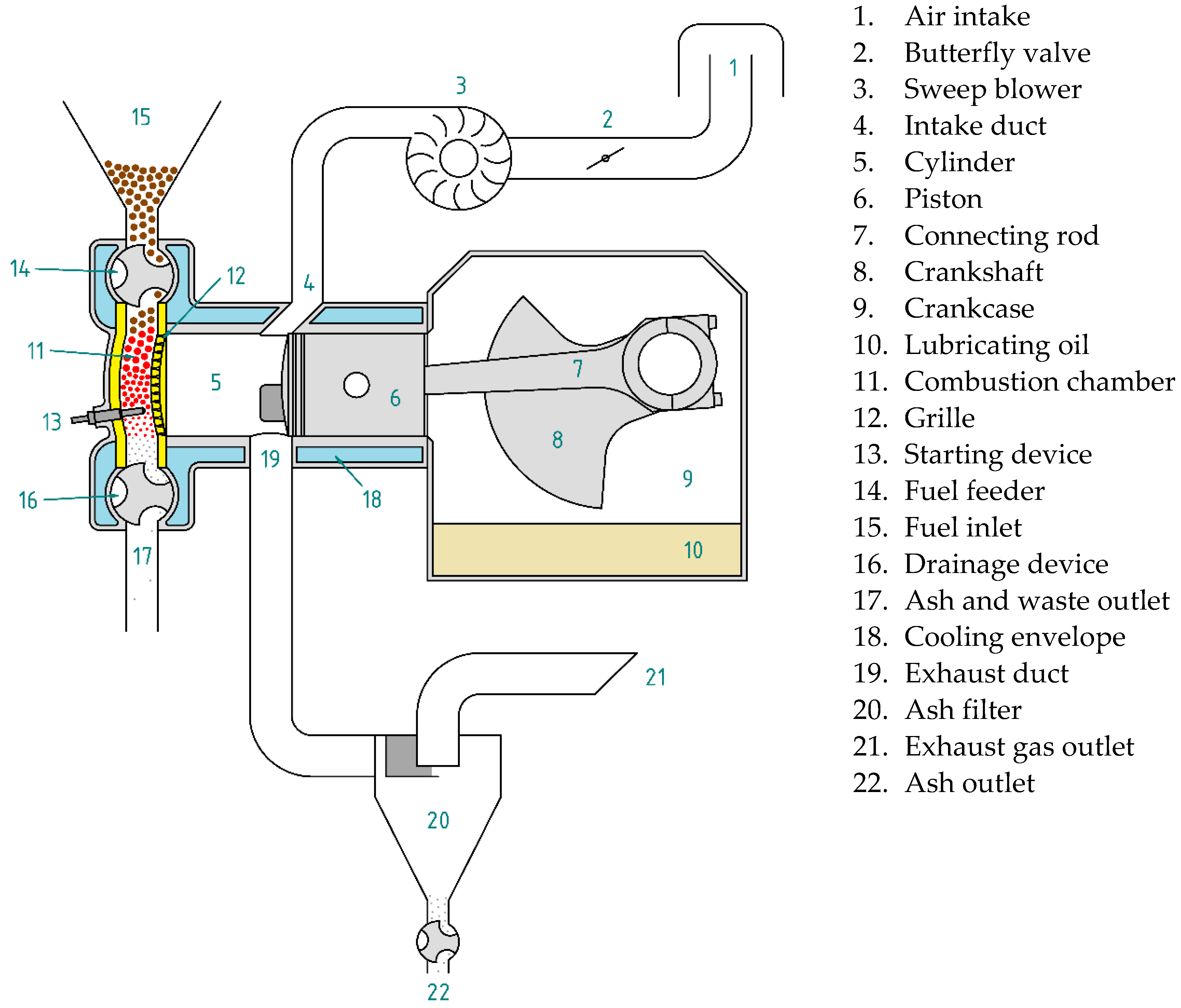

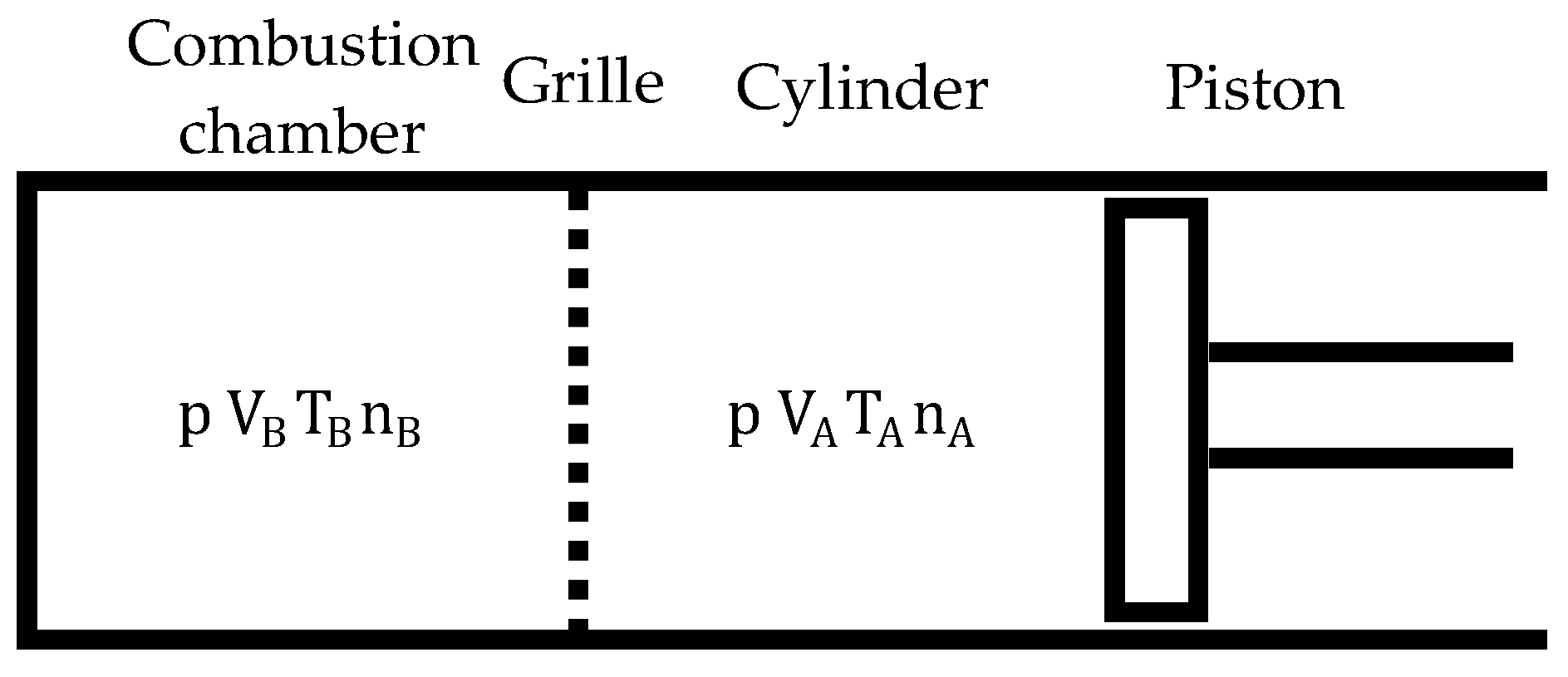

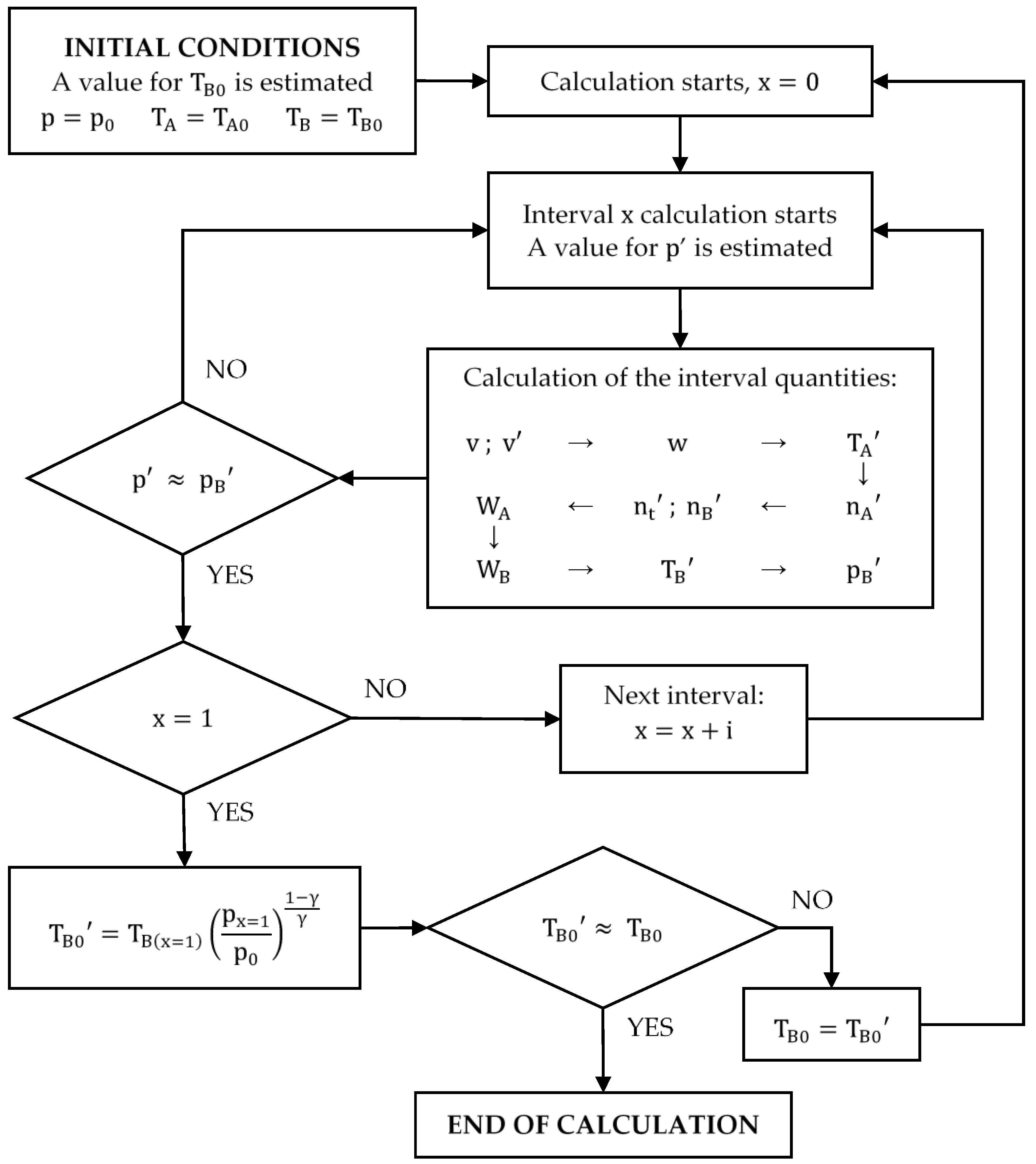
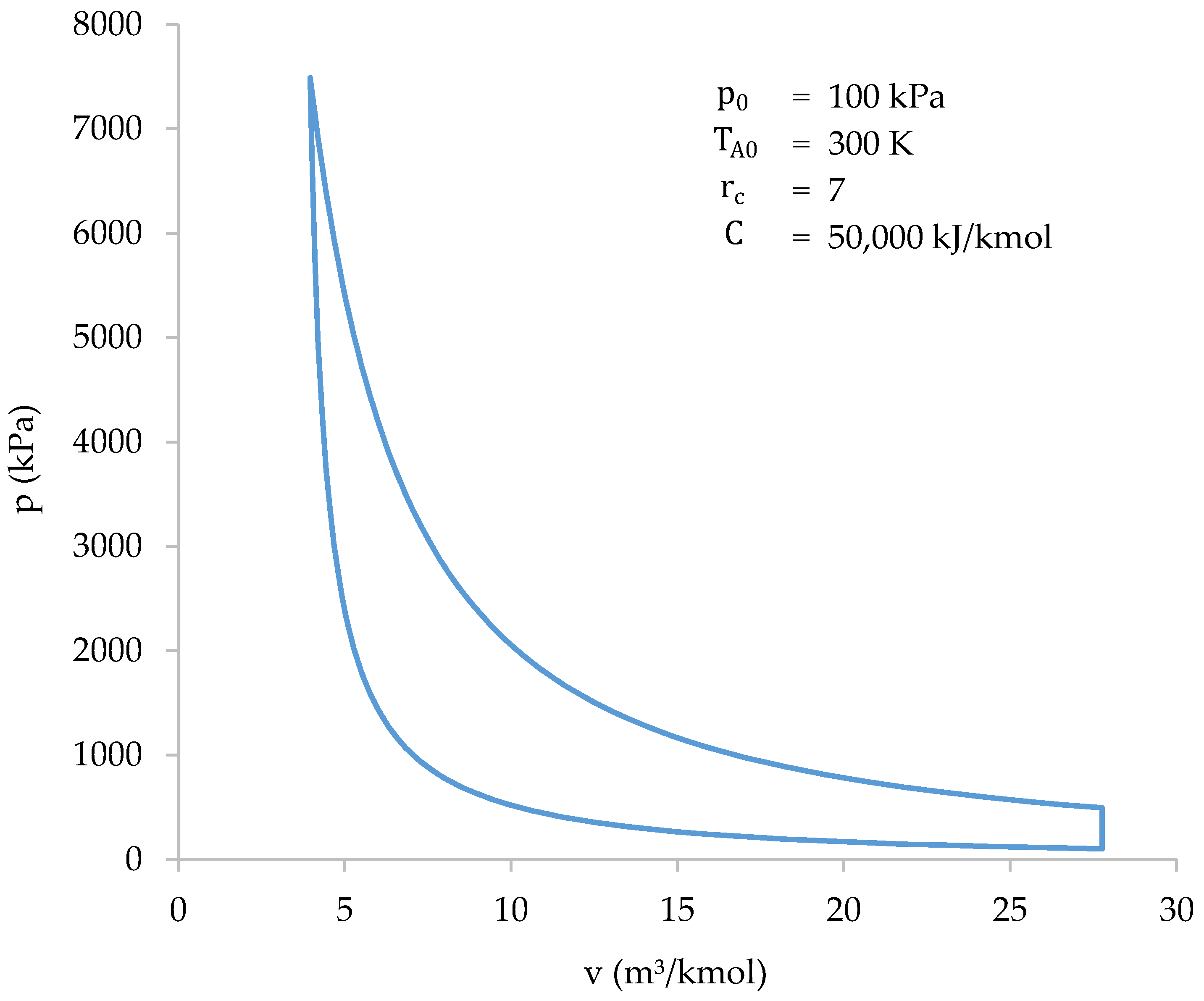
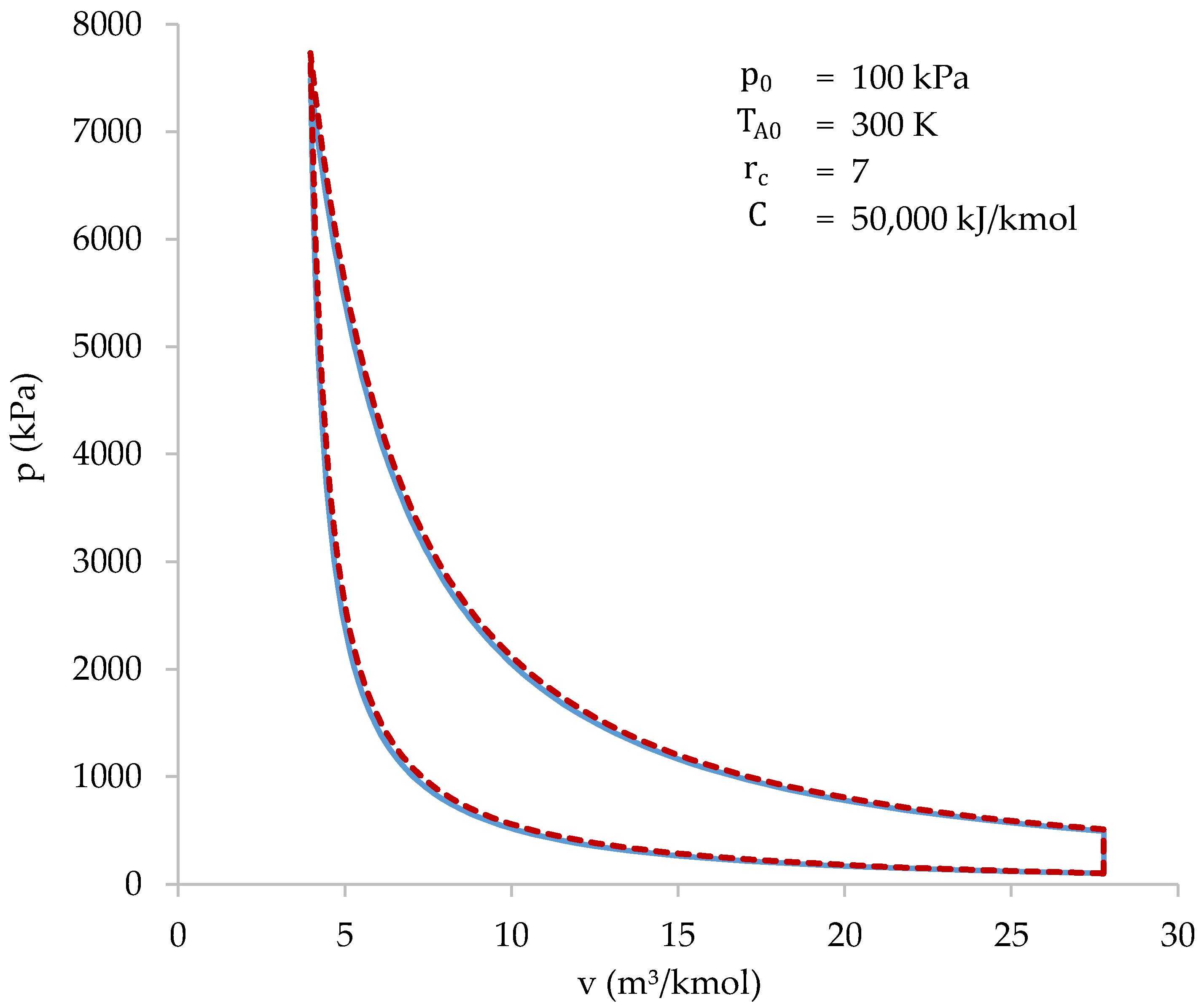



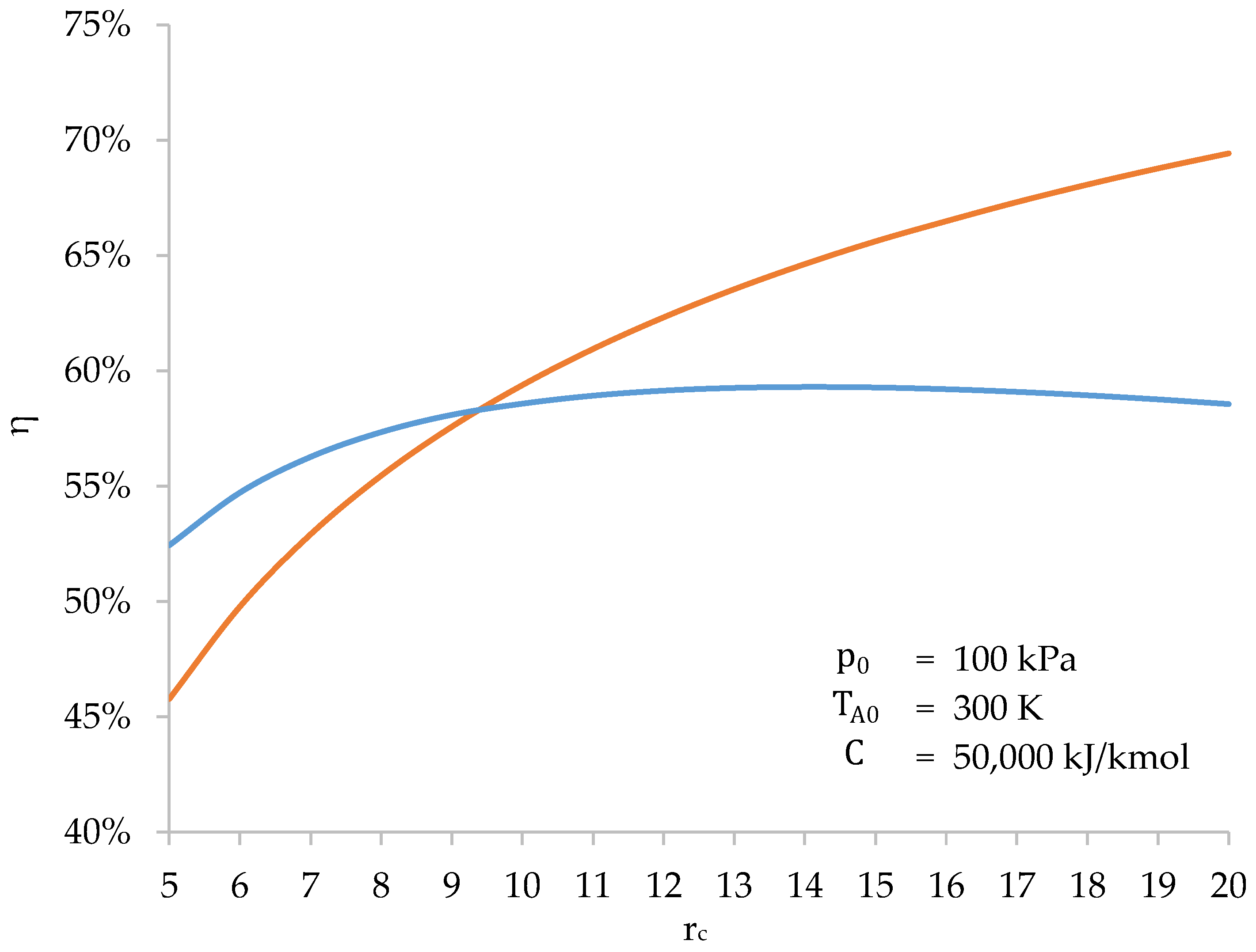

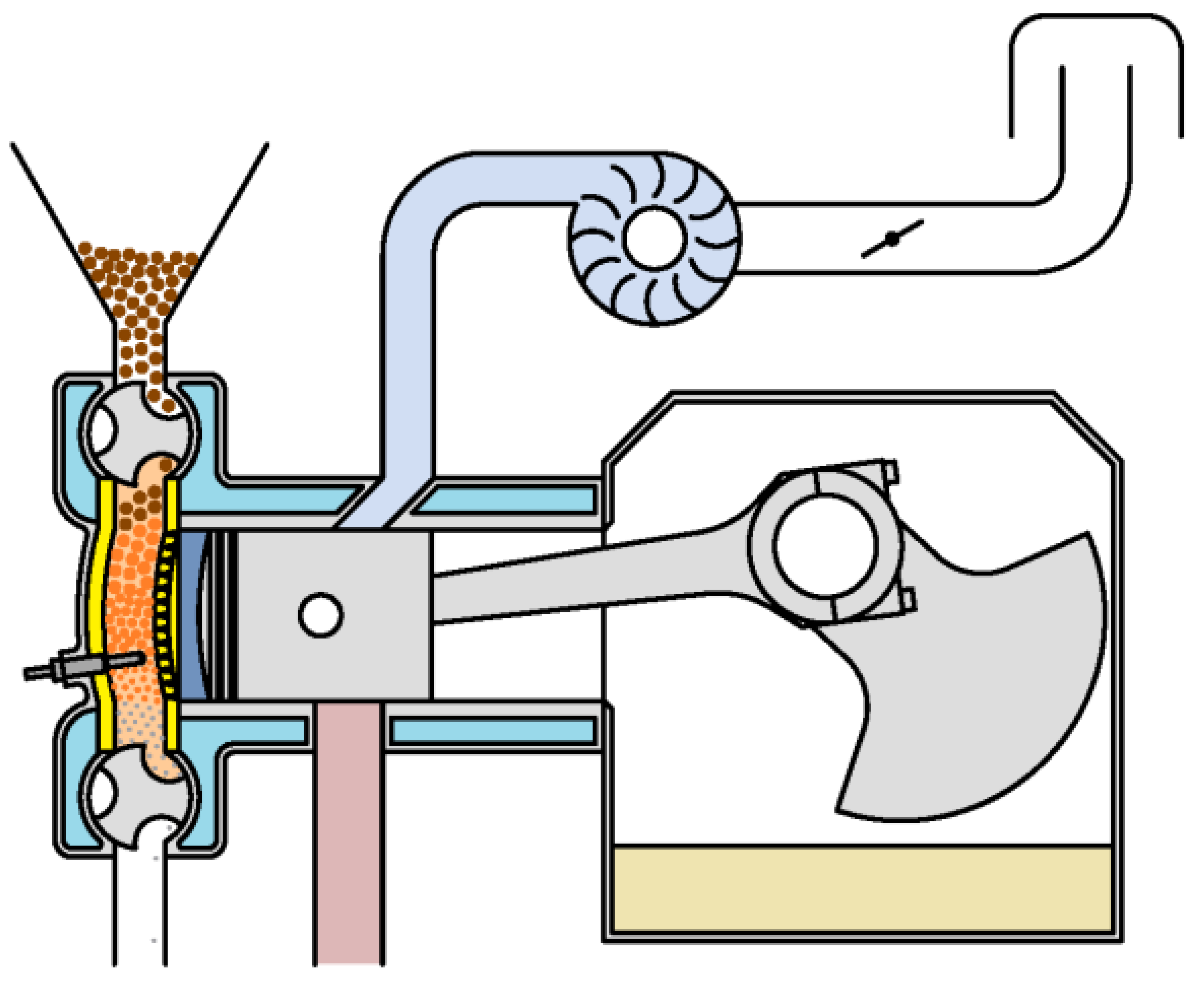 | I. Compression and absorption of heat (combustion). The gases present in the cylinder are compressed and introduced into the combustion chamber, where oxygen is consumed, raising the temperature of the gases present in the combustion chamber. |
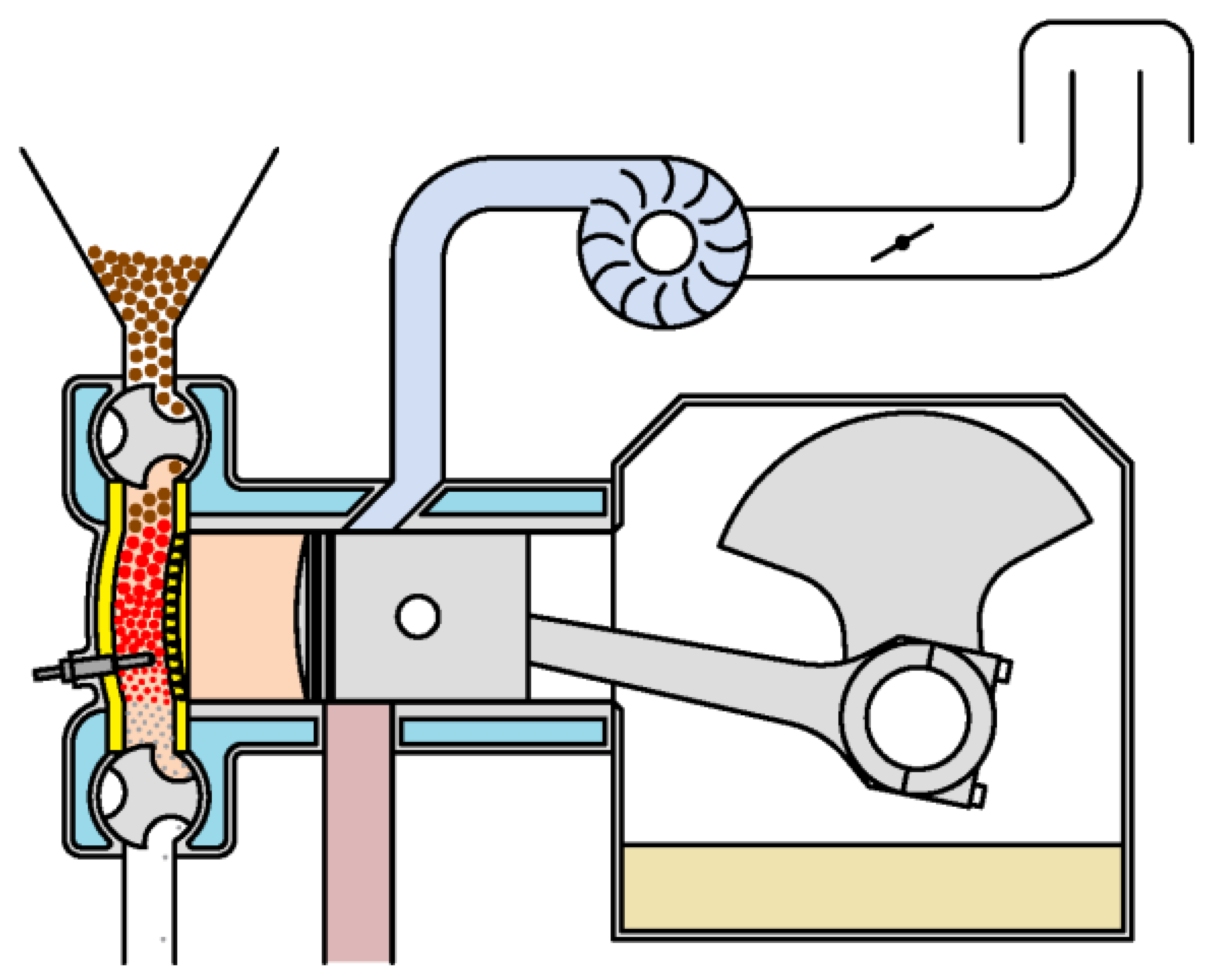 | II. Adiabatic expansion. The gases resulting from combustion expand in the cylinder, doing work. |
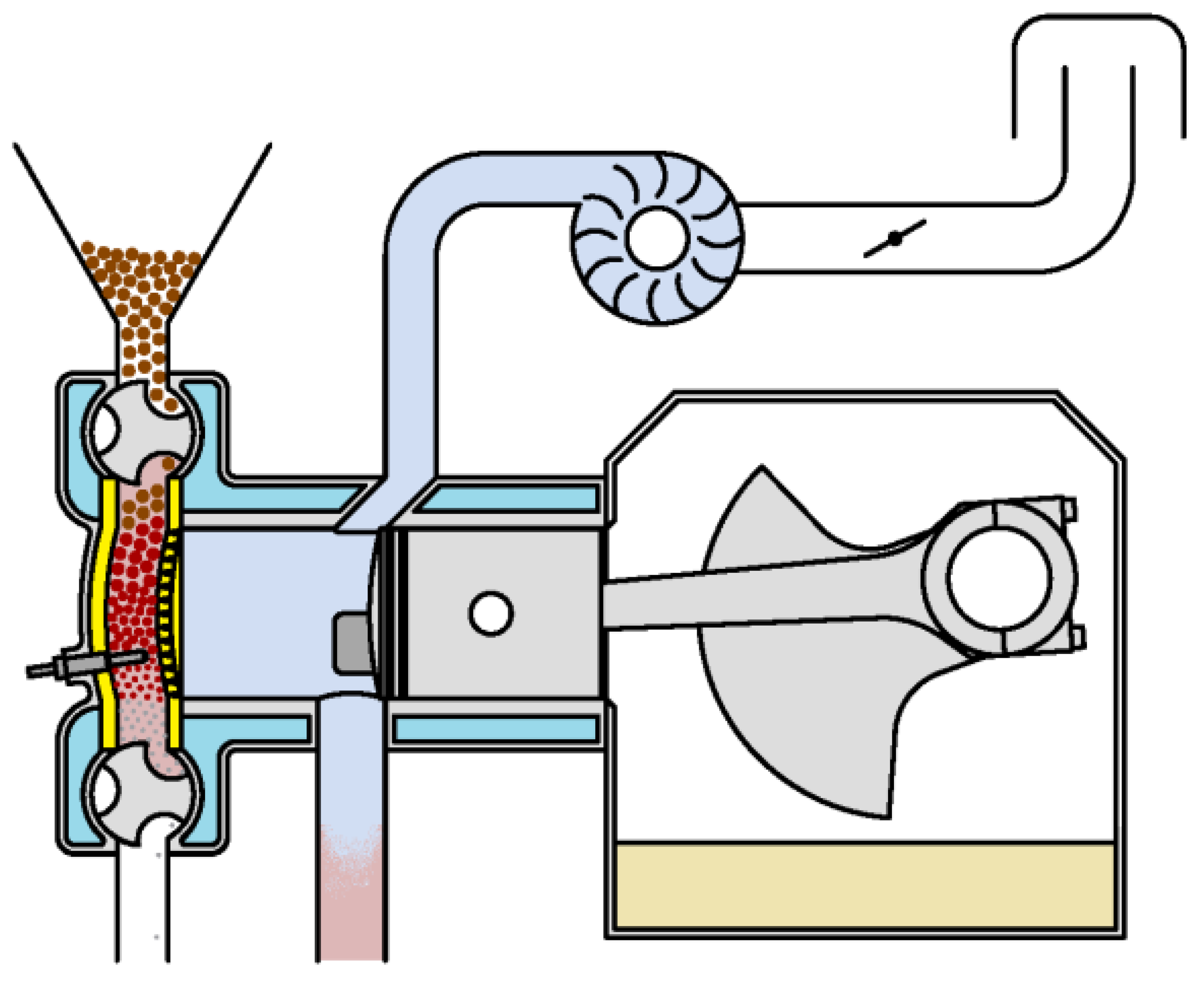 | III. Isochoric heat transfer, gas sweeping of the cylinder. The gases present in the cylinder are replaced by air from the atmosphere, whose temperature is lower. The gases present are expelled by the exhaust. |
| p0 | T0 | rc | C | K0 | K1 | K2 | K3 |
|---|---|---|---|---|---|---|---|
| (kPa) | (K) | (kJ/kmol) | |||||
| 100 | 300 | 10 | 50,000 | −134.7 | 3883 | −2.350 | −0.9163 |
| 120 | 300 | 10 | 50,000 | −161.6 | 3942 | −1.958 | −0.9163 |
| 180 | 300 | 10 | 50,000 | −242.2 | 4077 | −1.305 | −0.9163 |
| 220 | 300 | 10 | 50,000 | −296.2 | 4147 | −1.068 | −0.9163 |
| 270 | 300 | 10 | 50,000 | −363.4 | 4218 | −0.870 | −0.9178 |
| 120 | 250 | 10 | 50,000 | −164.5 | 3448 | −1.664 | −0.9178 |
| 120 | 275 | 10 | 50,000 | −163.1 | 3677 | −1.815 | −0.9114 |
| 120 | 300 | 10 | 50,000 | −161.6 | 3942 | −1.958 | −0.9163 |
| 120 | 325 | 10 | 50,000 | 158.6 | 4163 | −2.104 | −0.9122 |
| 120 | 350 | 10 | 50,000 | −155.9 | 4376 | −2.247 | −0.9085 |
| 120 | 300 | 5 | 50,000 | −123.4 | 3207 | −4.425 | −0.8819 |
| 120 | 300 | 7 | 50,000 | −142.3 | 3559 | −2.953 | −0.8979 |
| 120 | 300 | 10 | 50,000 | −161.6 | 3942 | −1.958 | −0.9163 |
| 120 | 300 | 14 | 50,000 | −177.7 | 4313 | −1.341 | −0.9363 |
| 120 | 300 | 20 | 50,000 | −190.7 | 4711 | −0.901 | −0.9606 |
| 120 | 300 | 10 | 25,000 | −136.0 | 3355 | −1.795 | −0.8833 |
| 120 | 300 | 10 | 35,000 | −148.1 | 3628 | −1.881 | −0.8987 |
| 120 | 300 | 10 | 50,000 | −161.6 | 3942 | −1.958 | −0.9163 |
| 120 | 300 | 10 | 70,000 | −173.7 | 4257 | −2.019 | −0.9348 |
| 120 | 300 | 10 | 100,000 | −184.6 | 4605 | −2.072 | −0.9568 |
| = | 100 | kPa | |
| = | 300 | K | |
| = | 7 | ||
| = | 50,000 | kJ/kmol |
| x | v (m3/kmol) | p (kPa) | nA (kmol) | nB (kmol) | TA (K) | TB (K) | w (kJ/kmol) | WA (kJ) | WB (kJ) | Δs (kJ/kmol K) |
|---|---|---|---|---|---|---|---|---|---|---|
| 0 | 27.77 | 100 | 0.9542 | 0.0458 | 300 | 1041 | 0 | 0 | 0 | 0 |
| 0.2 | 23.01 | 134 | 0.9389 | 0.0611 | 325 | 1043 | −550 | −510 | −40 | 0.733 |
| 0.4 | 18.25 | 192 | 0.9127 | 0.0873 | 361 | 1050 | −1312 | −1196 | −116 | 1.984 |
| 0.6 | 13.49 | 312 | 0.8611 | 0.1389 | 415 | 1073 | −2474 | −2190 | −284 | 4.416 |
| 0.75 | 9.917 | 525 | 0.7799 | 0.2201 | 481 | 1138 | −3914 | −3325 | −589 | 8.101 |
| 0.85 | 7.537 | 874 | 0.6733 | 0.3267 | 557 | 1276 | −5516 | −4466 | −1050 | 12.54 |
| 0.92 | 5.871 | 1516 | 0.5325 | 0.4675 | 652 | 1547 | −7416 | −5657 | −1759 | 17.58 |
| 0.94 | 5.395 | 1897 | 0.4687 | 0.5313 | 695 | 1704 | −8222 | −6106 | −2116 | 19.54 |
| 0.96 | 4.919 | 2521 | 0.3828 | 0.6172 | 754 | 1949 | −9261 | −6627 | −2634 | 21.90 |
| 0.98 | 4.443 | 3736 | 0.2535 | 0.7465 | 843 | 2388 | −10,715 | −7220 | −3495 | 24.90 |
| 0.99 | 4.205 | 4928 | 0.1545 | 0.8455 | 913 | 2781 | −11,736 | −7514 | −4222 | 26.82 |
| 1 | 3.97 | 7491 | 0 | 1 | 1028 | 3572 | −13,177 | −7701 | −5472 | 29.27 |
| 100 | ≤ | ≤ | 270 | kPa | |
| 250 | ≤ | ≤ | 350 | K | |
| 5 | ≤ | ≤ | 20 | ||
| 25,000 | ≤ | ≤ | 100,000 | kJ/kmol |
| Iterative-Numerical Method | Approximate Method | Difference | ||
|---|---|---|---|---|
| Initial volume | (m3/kmol) | 27.77 | 26.16 | 5.78% |
| Peak pressure | (kPa) | 7491 | 7733 | 3.23% |
| Compression work | (kJ/kmol) | −13,177 | −13,357 | 1.36% |
| Expansion work | (kJ/kmol) | 40,188 | 39,088 | 2.77% |
| Absorbed heat | (kJ/kmol) | 47,715 | 47,629 | 0.18% |
| Cycle efficiency | 56.64% | 54.03% | 4.62% |
| Biomass-Fueled Engine Cycle | Otto Cycle | ||
|---|---|---|---|
| Peak pressure | (kPa) | 7491 | 6562 |
| Peak temperature | (K) | 3572 | 3131 |
| Compression work | (kJ/kmol) | −13,177 | −8881 |
| Expansion work | (kJ/kmol) | 40,188 | 35,204 |
| Total work | (kJ/kmol) | 27,009 | 26,323 |
| Absorbed heat | (kJ/kmol) | 47,709 | 50,000 |
| Cycle efficiency | 56.61% | 52.65% |
Disclaimer/Publisher’s Note: The statements, opinions and data contained in all publications are solely those of the individual author(s) and contributor(s) and not of MDPI and/or the editor(s). MDPI and/or the editor(s) disclaim responsibility for any injury to people or property resulting from any ideas, methods, instructions or products referred to in the content. |
© 2023 by the authors. Licensee MDPI, Basel, Switzerland. This article is an open access article distributed under the terms and conditions of the Creative Commons Attribution (CC BY) license (https://creativecommons.org/licenses/by/4.0/).
Share and Cite
Suanes, G.; Bolonio, D.; Cantero, A. Definition of the Thermodynamic Cycle of a Biomass-Fueled Internal Combustion Engine. Energies 2023, 16, 896. https://doi.org/10.3390/en16020896
Suanes G, Bolonio D, Cantero A. Definition of the Thermodynamic Cycle of a Biomass-Fueled Internal Combustion Engine. Energies. 2023; 16(2):896. https://doi.org/10.3390/en16020896
Chicago/Turabian StyleSuanes, Gonzalo, David Bolonio, and Antonio Cantero. 2023. "Definition of the Thermodynamic Cycle of a Biomass-Fueled Internal Combustion Engine" Energies 16, no. 2: 896. https://doi.org/10.3390/en16020896
APA StyleSuanes, G., Bolonio, D., & Cantero, A. (2023). Definition of the Thermodynamic Cycle of a Biomass-Fueled Internal Combustion Engine. Energies, 16(2), 896. https://doi.org/10.3390/en16020896








